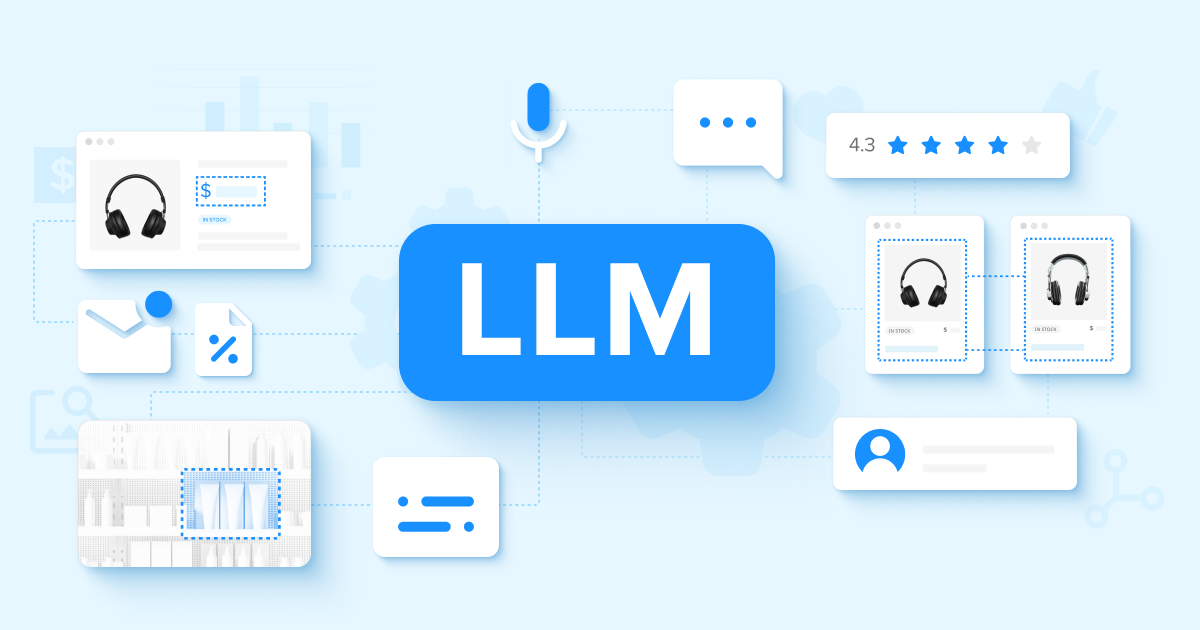The question we hear most from customers is: How can LLMs help us better compete? In this post and future posts, we will cover all aspects of data science and artificial intelligence in ecommerce today, and how different concepts are applied to improve a range of key performance indicators (KPIs) across both brands and retailers. By leveraging LLMs, businesses can achieve higher conversion rates, improved customer satisfaction, and increased revenue growth.
What Are Large Language Models (LLMs)?
Large Language Models (LLMs) are one type of artificial intelligence programs. They are systems trained on vast amounts of text data and designed to understand and generate human language. They make incredibly powerful tools for a range of applications, including natural language processing (NLP), translation, content creation, and more.
Take ChatGPT, for example. ChatGPT uses a Large Language Model (LLM) to understand questions and generate responses. When you ask a question, ChatGPT processes the input text, looks at the context, and uses its knowledge of language patterns to predict and generate a response. The model relies on the vast amount of data it was trained on, combined with its ability to remember the conversation context, to provide relevant and coherent answers.
In the context of e-commerce, LLMs can be utilized to enhance data collection capabilities, develop intelligent data services, and improve the accuracy and reliability of various data-driven products. Below are some examples:
Enhancing Data Collection Capabilities
- Automated Data Extraction: LLMs can automatically extract relevant information from vast amounts of unstructured data such as customer reviews, product descriptions, and social media posts. This helps businesses gather insights without the need for extensive manual data entry.
- Natural Language Processing (NLP): LLMs excel at understanding and processing human language, allowing them to interpret and analyze textual data more effectively. This capability enables businesses to understand customer sentiments, detect emerging trends, and identify common pain points.
- Data Enrichment: By integrating data from multiple sources, LLMs can enrich existing datasets with additional context and information. For example, they can merge sales data with customer feedback to provide a more comprehensive view of product performance.
Developing Intelligent Data Services
- Personalized Recommendations: LLMs can analyze user behavior and preferences to generate highly personalized product recommendations. This not only enhances the shopping experience but also increases the likelihood of conversions and repeat purchases.
- Search Optimization: LLMs improve search functionality by understanding natural language queries and providing more accurate search results. They can interpret user intent and deliver relevant products, even if the search terms are vague or imprecise.
Improving Accuracy and Reliability of Data-Driven Products
- Predictive Analytics: LLMs can analyze historical data to identify patterns and trends, enabling businesses to make data-driven predictions about future sales, inventory needs, and customer behavior. This helps in strategic planning and optimizing operations.
- Compliance and Quality Control: LLMs can ensure that product listings comply with regulatory standards and internal quality guidelines. They can flag discrepancies, incorrect information, and potential violations of MAP policies, maintaining the integrity of product data.
LLMs to Improve Exact and Similar Product Matching
One of the most common and well-used applications is to leverage LLMs as recommendation systems. Like other similarity models, LLMs can help identify exact-match and similar-matched products to improve a business’s ability to benchmark themselves against others.
About Exact vs Similar-Matches
An exact match of a product refers to finding the same unique product across different websites, ensuring that all attributes—such as brand, model, year, color, and other specifications—are identical. For example, if you are searching for a “2023 Apple iPhone 14 Pro, 128GB, Space Gray,” an exact match would be the same model with the same specifications available across different e-commerce platforms like Amazon, Best Buy, or the Apple Store.
In contrast, a similar-match, or like-match, refers to products that, while not identical in every attribute, are considered equivalent by users for practical purposes. These products may differ in certain aspects such as brand or color but serve the same function or fulfill the same need. For example, if someone is looking for a smartphone with similar features to the “2023 Apple iPhone 14 Pro,” a similar match might be the “Samsung Galaxy S23, 128GB, Phantom Black.” Although the brands and models differ, both products offer comparable features, making them viable alternatives in the eyes of the consumer.
This distinction is crucial in e-commerce. Exact matches are necessary in many cases where a retailer, for instance, wants to track what its competitors are pricing for the exact same products. On the other hand, similar-matches have become more necessary as brands or retailers seek to better understand how they compete when it comes to exclusive products or competitors’ private label goods. In both examples, there generally isn’t an obvious attribute, or set of attributes, to match against, so we rely on LLMs to help inform what makes the most sense from a comparative standpoint. LLMs achieve this by exploring and understanding unstructured product data in its entirety, such as descriptions, attributes, customer reviews, and even social media, to generate similar-product recommendations.
LLMs to Support Data Enrichment
Before LLMs, data labeling— the process of annotating data with meaningful tags or labels to make it understandable for machine learning models— was very difficult or nearly impossible. LLMs can now generate semi-labeled data, which means they can automatically assign some labels to data, reducing the amount of manual effort required and enriching the data in a scalable way.
Regarding identifying exact matches, labeled data is critical for matching and later analyzing, across different eCommerce platforms. Labels like brand, model, year, and color help ensure that comparisons are accurate. For similar matches, labeled data helps in comparing products that may differ in some attributes but serve the same function or meet similar customer needs. For example, a “Samsung Galaxy S23, 128GB, Phantom Black” might be tagged with attributes like “smartphone,” “128GB storage,” and “black color.” These labels enable the system to identify it as a similar match to the iPhone 14 Pro, despite brand differences.
Greater Insights and Data Quality for All
Retailers and brands already have access to a vast amount of pricing insights today, which they use for everything from price management and price optimization to digital shelf analytics and enforcing price policies (such as MAP). At Wiser we’re now incorporating this sort of intelligence into our LLM-led analysis to gain deeper insights into areas like historical pricing trends, product popularity, the impact of seasonal changes on pricing strategies, and, where applicable, customer behavior. By understanding how pricing strategies are executed and adjusted in real-time, our customers can benefit from this knowledge to fine-tune their own pricing strategies. In practice, this means that in the future our customers won’t just track competitors’ actions but will also be able to predict the best times to offer promotions and make other strategic adjustments.
The integration of Large Language Models (LLMs) into e-commerce strategies offers a transformative approach to data collection, matching, and analysis. By leveraging the advanced capabilities of LLMs, businesses can achieve more accurate product matching, gain deeper insights into pricing strategies, and enhance their overall data-driven decision-making processes. As we continue to explore and implement these technologies, the potential for innovation and improved customer experiences is vast.
Conclusion and Future Prospects
The integration of Large Language Models (LLMs) into e-commerce strategies offers a transformative approach to data collection, matching, and analysis. By leveraging the advanced capabilities of LLMs, businesses can achieve more accurate product matching, gain deeper insights into pricing strategies, and enhance their overall data-driven decision-making processes. As we continue to explore and implement these technologies, the potential for innovation and improved customer experiences is vast.
Stay tuned for next month’s entry, where we will delve deeper into similar-matching and its impact on competitive positioning. Thank you for reading!
About the Author:
Paul Turner leads the new Platform product team at Wiser, where he focuses on enhancing our data collection capabilities and intelligent data services, including advanced matching algorithms, to deliver superior and reliable data across all Wiser products. With an impressive background in large data sets, data science, and the implementation of large-scale platforms, Paul brings a wealth of expertise to his role. He excels in product strategy and the development of innovative services, utilizing Natural Language Understanding (NLU) and Natural Language Processing (NLP) models to drive new product development.









